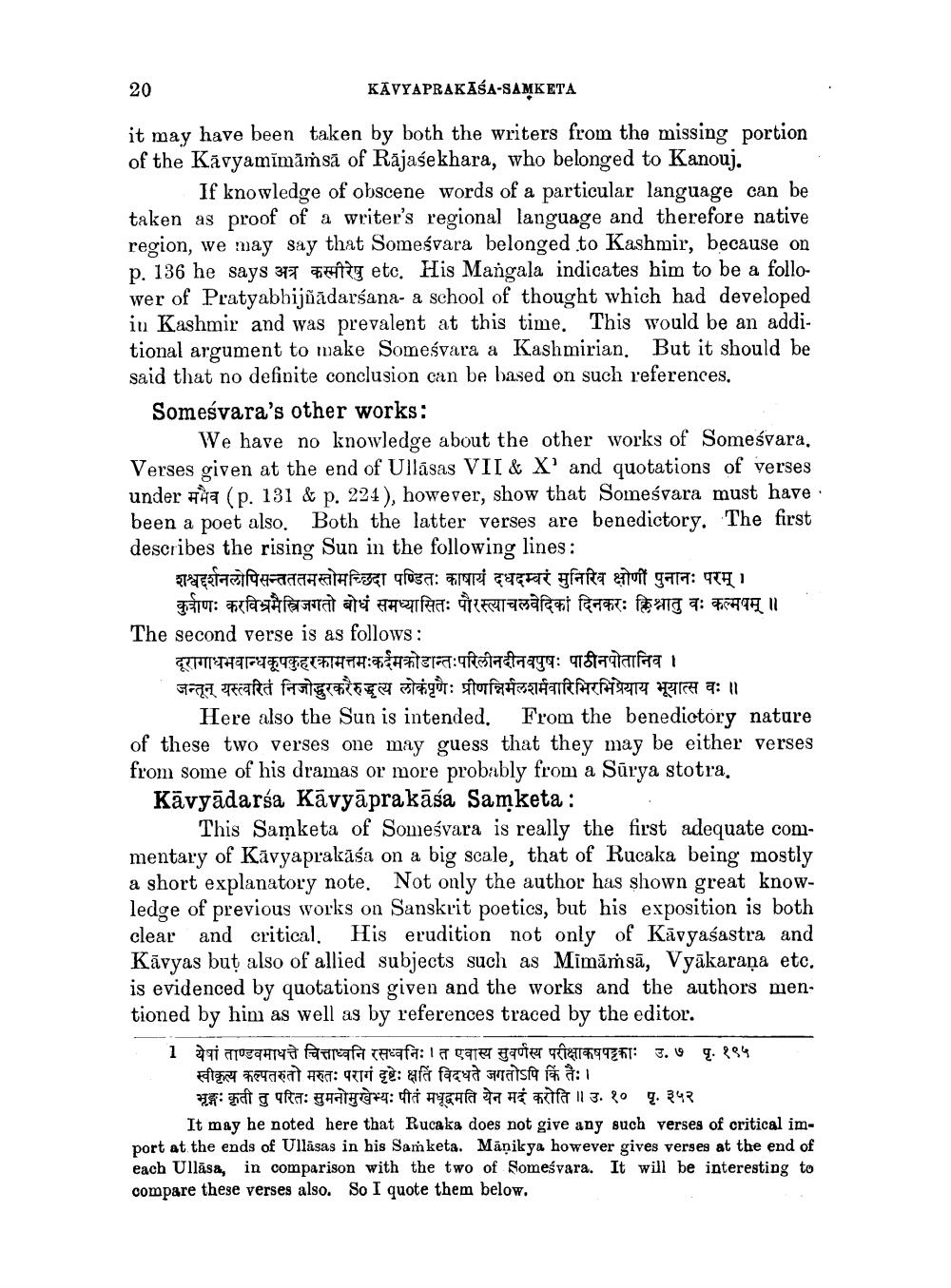________________
20
KĀVYAPRAKASA-SAMKETA
it may have been taken by both the writers from the missing portion of the Kāvyamīmāṁsā of Rājasekhara, who belonged to Kanouj.
If knowledge of obscene words of a particular language can be taken as proof of a writer's regional language and therefore native region, we may say that Someśvara belonged to Kashmir, because on p. 136 he says 377 ty etc. His Mangala indicates him to be a follower of Pratyabhijñādarśana- a school of thought which had developed in Kashmir and was prevalent at this time. This would be an additional argument to make Someśvara a Kashmirian. But it should be said that no definite conclusion can be based on such references. Someśvara's other works:
We have no knowledge about the other works of Someśvara, Verses given at the end of Ullásas VII & X and quotations of verses under Ha (p. 131 & p. 224), however, show that Someśvara must have been a poet also. Both the latter verses are benedictory. The first describes the rising Sun in the following lines:
शश्वदर्शनलोपिसन्तततमस्तोमच्छिदा पण्डितः काषायं दधदम्बरं मुनिरिव क्षोणी पुनानः परम् ।
कुर्वाणः करविभ्रमैत्रिजगतो बोधं समध्यासितः पौरस्त्याचलवेदिकां दिनकरः क्लिश्नातु वः कल्मषम् ॥ The second verse is as follows:
दूरागाधभवान्धकूपकुहरक्रामत्तमःकर्दमकोडान्तःपरिलीनदीनवपुषः पाठीनपोतानिव । जन्तून् यस्त्वरित निजोद्धरकरैरुद्धृत्य लोकंपृणैः प्रीणन्निर्मलशर्मवारिभिरभिप्रेयाय भूयात्स वः ॥
Here also the Sun is intended. From the benedictory nature of these two verses one may guess that they may be either verses from some of his dramas or more probably from a Sūrya stotra. Kāvyādarśa Kāvyāprakāsa Samketa:
This Samketa of Someśvara is really the first adequate commentary of Kävyaprakāśa on a big scale, that of Rucaka being mostly a short explanatory note. Not only the author has shown great knowledge of previous works on Sanskrit poetics, but his exposition is both clear and critical. His erudition not only of Kāvyasastra and Kāvyas but also of allied subjects such as Mimāṁsā, Vyākaraṇa etc. is evidenced by quotations given and the works and the authors mentioned by him as well as by references traced by the editor. 1 येषां ताण्डवमाधत्ते चित्ताध्वनि रसध्वनिः । त एवास्य सुवर्णस्य परीक्षाकषपट्टकाः उ.७ पृ. १९५
स्वीकृत्य कल्पतरुतो मरुतः परागं दृष्टेः क्षतिं विदधते जगतोऽपि किं तैः। भृङ्गः कृती तु परितः सुमनोमुखेभ्यः पीतं मधूद्वमति येन मदं करोति ॥ उ. १० पृ. ३५२
It may be noted here that Rucaka does not give any such verses of critical import at the ends of Ullāsas in his Samketa. Māņikya however gives verses at the end of each Ullāsa, in comparison with the two of Someśvara. It will be interesting to compare these verses also. So I quote them below.




